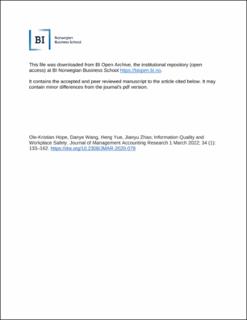| dc.contributor.author | Hope, Ole-Kristian | |
| dc.contributor.author | Wang, Danye | |
| dc.contributor.author | Yue, Heng | |
| dc.contributor.author | Zhao, Jianyu | |
| dc.date.accessioned | 2024-02-02T09:40:45Z | |
| dc.date.available | 2024-02-02T09:40:45Z | |
| dc.date.created | 2022-09-08T14:31:52Z | |
| dc.date.issued | 2022 | |
| dc.identifier.citation | Journal of Management Accounting Research. 2022, 34 (1), 133-162. | en_US |
| dc.identifier.issn | 1049-2127 | |
| dc.identifier.uri | https://hdl.handle.net/11250/3115216 | |
| dc.description.abstract | This paper examines the effect of internal information quality on workplace safety. Using establishmentlevel data on workplace injuries from the Occupational Safety and Health Administration (OSHA) and employing a strict fixed-effects structure, we show that higher information quality is associated with significantly lower work-related injury rates. Further investigation reveals that the effect is stronger when more decision rights reside in headquarters, weaker when employees have greater bargaining power, and weaker when firms are subject to financial constraints. Our findings are robust to the use of two plausibly exogenous shocks and other robustness checks. Our study suggests an important economic consequence of information quality not examined by prior literature. | en_US |
| dc.language.iso | eng | en_US |
| dc.title | Information Quality and Workplace Safety | en_US |
| dc.title.alternative | Information Quality and Workplace Safety | en_US |
| dc.type | Journal article | en_US |
| dc.type | Peer reviewed | en_US |
| dc.description.version | acceptedVersion | en_US |
| dc.source.pagenumber | 133-162 | en_US |
| dc.source.volume | 34 | en_US |
| dc.source.journal | Journal of Management Accounting Research | en_US |
| dc.source.issue | 1 | en_US |
| dc.identifier.doi | 10.2308/JMAR-2020-079 | |
| dc.identifier.cristin | 2049986 | |
| cristin.ispublished | true | |
| cristin.fulltext | postprint | |
| cristin.qualitycode | 1 | |
